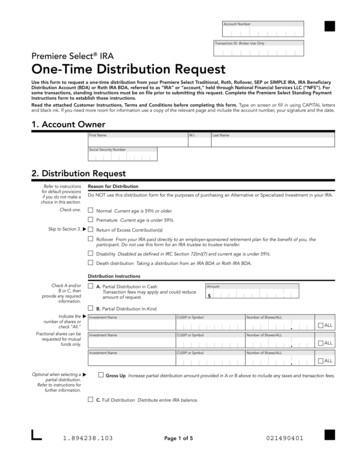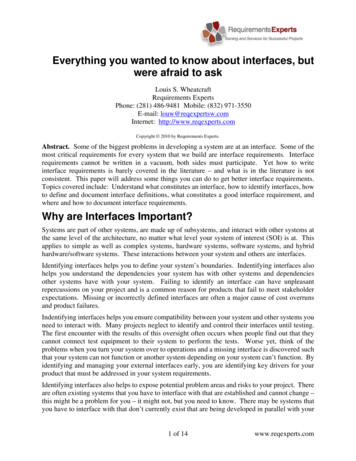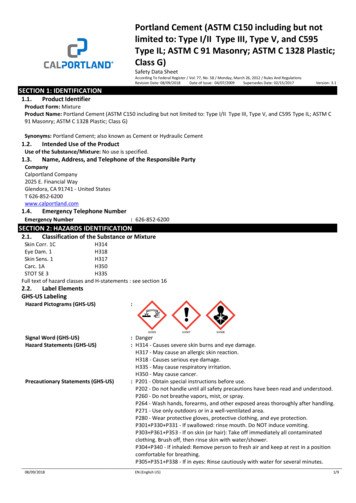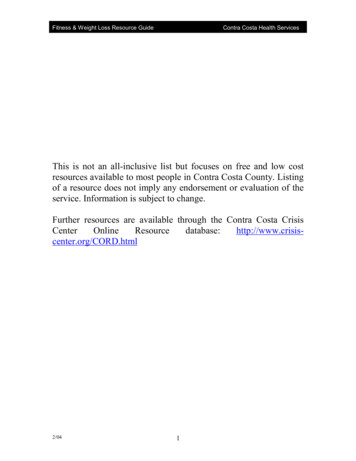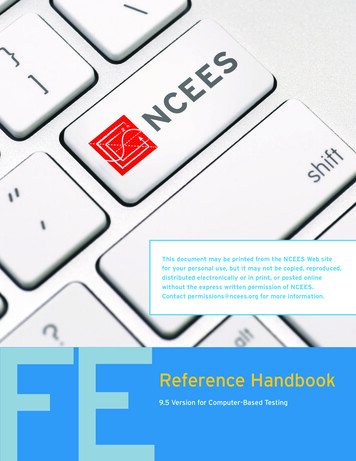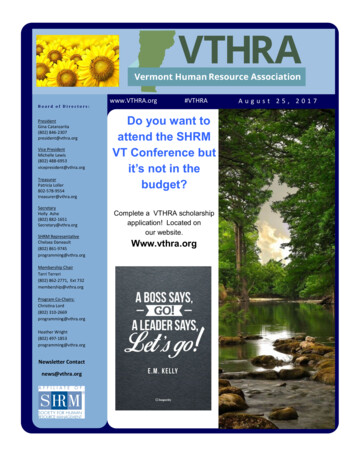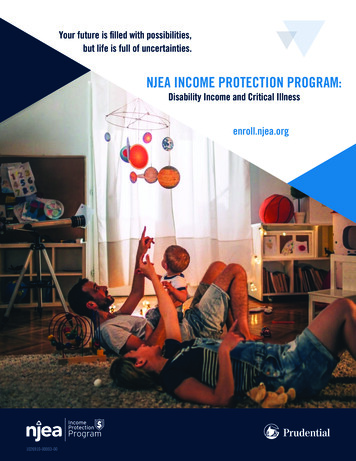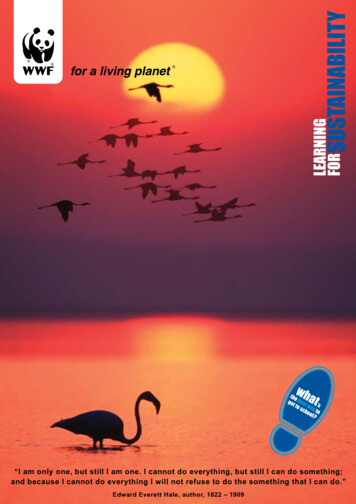
Transcription
“I am only one, but still I am one. I cannot do everything, but still I can do something;and because I cannot do everything I will not refuse to do the something that I can do.”Edward Everett Hale, author, 1822 – 1909
points identified in the National Frameworkfor Sustainable Schools, published by theDepartment for Children, Schools and Families(formerly DfES) in January 2007.See the‘In focus’ section for more details.The National Framework defines a sustainable schoolas one that places the principle of care at the centre ofeverything that it does: Care for oneself Care for each other Care for the environment.The travel and traffic doorway provides opportunitiesto investigate questions touching upon each of theseaspects of care e.g. Do pupils and parents realise thatwalking to and from school could be an important partof their daily exercise? Does travelling to school by carmake it more dangerous for others to walk or cycle?How does the traffic generated by your school affectissues like local air quality and global warming?Let’s make the ClimateChange Bill work!You may be aware that the Government is currentlypreparing a new Climate Change Bill. WWF welcomesthis Bill and believes that this is arguably the mostimportant environmental legislation to go beforeParliament. However, if the UK is going to deliver its fairshare of the responsibility fortackling the global climatechangechallenge,weneed to strengthen the Bill.Particularly, WWF are callingfor the CO2 reduction targetsto be raised from 60% to 80%and for aviation and shippingto be included in the Bill.Every voice counts in gettingthis Bill strengthened andyou and your pupils can getinvolved but time is short! Visitwww.wwflearning.org.ukfor more information.WWF-UKINSIDE THIS ISSUE A2 full colour poster with inspirationalquotation Questions to explore the poster image andquotation Starter activity ideas with links to furtheronline activities ‘In focus’ – an insight into the issues oftransport and how it relates to school life.Get involved in the ‘Velvet YoungNature Photographer of the Year’CompetitionWWF and Velvet have recently joined forces tocreate a brand new competition called the ‘VelvetYoung Nature Photographer of the Year’. It’s aperfect partnership as both WWF and SCA (themaker of Velvet) want to encourage children tothink about the environment and help them topreserve the planet’s resources.Working together to protect theenvironmentSCA recently came top in a WWF survey of the big5 tissue manufacturers, who make up 75% of theEuropean market, based on their environmentalperformance. In fact SCA has worked hard tomanage the trees it grows in a way that benefitsboth people and nature.The perfect half-term projectThere are two photo entry themes, either ‘Species’or ‘Spaces’ and children up to the age of 16 cantake part. Pupils can enter either individually or asa class.There are numerous fantastic prizes on offer andone Grand Prize winner will be crowned the ‘VelvetYoung Nature Photographer of the Year’. The competition ends 7th January 2008 Prizes include a luxury family weekend away,photographic equipment for your school, WWFdiaries and adoption of an animal Entries can be sent by email, post or through thewebsite.For more details on how to enter and get yourpupils involved, go to:www.velvetbabymd.com/wwfPanda House, Weyside Park, Godalming, Surrey GU7 1XR01483 426444 f: 01483 426409www.wwflearning.org.ukIDEAS FOR THE CLASSROOMWalk to school monthFlamingosEncourage your pupils to use the ‘movies’ and ‘images’section on the www.arkive.org website to create a shortnews item about flamingos. Pupils should be asked toinclude information about appearance, behaviour andpredators. The ‘more information’ section will help pupilsto find out more – including information about threats andconservation.Linking travel, trafficand climate changeInvite pupils to use the followingweblinks to explore the links betweentravel, traffic and climate change. The images from the photogallery will help them to create a mapping diagram thatexplains these 1 s.htmlInternational Walk to School Monthtakes place in October 2007. Togetherwith your pupils, make a plan that willensure that your school is fully involved. Think about pupils,parents and all of the adults that work at your school.www.walktoschool.org.ukDeclarationYour school can create a ‘Sustainable travel and trafficdeclaration’ – a statement of intent that’s been developedand accepted by your school community. WWF would liketo invite you to share this declaration with others throughits education website – wwflearning.org.uk. Send yourdeclaration to kgates@wwf.org.uk. We will send you acertificate to commend your declaration.Travel and trafficAsk pupils to reflect on the following:I think the key issues about travel andtraffic in school are This topic has helped me realise that In future I will Invite pupils to reflect on the quote on the front of the poster:Should we act as if what we do makes a difference?Let’s seeImagine that your school is planning to take 10 childrenon a trip to see flamingos in the wild. Ask pupils to use thefollowing websites to find the approximate carbon emissionsthat would result from trips to the countries where thesebirds live. Pupils could then use the material to produce apresentation to persuade the school to cancel this trip.www.arkive.orgwww.carbonfootprint.com/flight calc.htmlListening to lichenThe exhaust fumes from petrol and diesel engines containgreenhouse gases and pollutants that can cause serioushealth problems. Encourage your pupils to collect samplesof lichen on twigs. They can then use the following onlineguide to find out what lichen can tell you about the airpollution where you uide/What do you think ?Ask pupils to answer the followingquestions:1. UK cars average CO2 emissions: a)17g/km b) 170g/km c) 17kg/km(NB A party balloon would hold about 10g of CO2)2. The percentage of children who walk or cycle to school:Netherlands a) 55% b) 65% c) 75%UKa) 40% b) 50% c) 60%3. Annual UK deaths and injuries resulting from ‘school run’related traffic congestion is approximately:a) 7,000 b) 700 c) 704. By 2050, climate change could cause:Species extinctions – a) 10,000 b) 100,000 c) 1,000,000Refugees – a) 2 million b) 20 million c) 200 millionEspresso linksPupils can use the following website to calculate the effectsof their transport emissions. They can then describe theirreactions to the findings and explain what steps could betaken to reduce the environmental impact of their travel:www.travelcalculator.org/calc.htmlAs you maybe aware, WWF has a partnership with EspressoEducation. If you are a subscriber to Espresso, you canfind WWF’s Sustainability Module under the Geography 2Channnel. Here are some links to complement this issue ofLearn.As a school you may wish to explore the Schools’ GlobalFootprint calculator and make notes about the differentways that your school community could reduce its travelfootprint. This version is specific to Scotland ment/findresources/globalfootprint/index.aspWhat can you see?2.What sort of birds are they? Where doyou think they live? How could you findout more about them?Why do birds and other animals travelfrom one place to another? How dothey travel? How does this affect theenvironment?Why do we travel from one place toanother? How do we travel? How doesthis affect the environment?What’s the link between travel andclimate change?How might these birds and theirhabitat be affected by climate change? What can they do about it?Why might travelling by plane to see these birds in the wild be especially bad forthe environment?Think about different ways to travel between home and school. Where would youplace them on the following line?3.Q4.QQQQ5.6.7.8.“I am on ly one, bu t sti ll Iam on e. I caan d be ca usnn ot do ev erye I ca nn ot dothi ng , bu t stiev ery thi ngll I ca n do soI wi ll no t refme thi ng ;us e to do theso me thi ng thaEd wa rd Everet t Ha le, autt I ca n do .”hor, 182 2 –1909less sustainableQQHow could we make some of these forms of transport more sustainable?10.Think about how you might create a sustainable travel plan for your school. Whatdo you need to know? How will you find out? How will you persuade people totravel more sustainably? How will you know if you’ve made a difference?How might you persuade your parents, friends and other people to travel moresustainably?Look at the quote at the bottom of the poster. What do you think it means? Thinkabout the ways in which you travel. What things would you include in a list entitled‘the something that I can do’?QQ11.12.IN FOCUSTravel &traffic“By 2020 the Government would like allschools to be models of sustainable travel,where vehicles are used only when absolutelynecessary and where there are exemplaryfacilities for healthier, less polluting or lessdangerous modes of transport.”Sustainable Schools, National Framework, DfESThe planet has already warmed by about 0.7oCand urgent action is required if we are to avoidexceeding the critical threshold of 2 oC abovepre-industrial levels. In order to achieve this,industrialised countries will need to secure an80% reduction in CO2 emissions by 2050.In 2002, transport accounted for 21% ofgreenhouse gas emissions in the EU. In thatsame year, the EU announced that all sectorsof the economy had managed to reduce theiremissions below 1990 levels – apart from thetransport sector where emissions rose by 22%.Increased emissions from road transporthave been caused by the increase in vehiclenumbers and usage – swallowing-up the benefitsof technological developments like improvedvehicle fuel consumption and reduced emissions.Current UK trends suggest that by 2020, roadtransport will provide the largest source ofgreenhouse gas emissions and aviation is alreadythe fastest-growing source of emissions.Want to explore things further?Check out more activities atwww.wwflearning.org.ukSo how can schools help?Action to reduce greenhouse gasemissions from the transport sectoris urgently required. Schools have animportant role to play – by educating pupilsabout the issues, by taking the messageto a wider audience and by taking actionto reduce the carbon footprint arising fromthe travel and traffic generated by theschool. You can also take part in WWF’sClimate Change Bill Campaign – seewww.wwflearning.org.uk for moreinformation.Factbites – Did youknow.?A recent report by the Institute forEuropean Environmental Policy blamesover-use of cars for fuelling the ‘twincrises’ of global warming and an obesityepidemic and calls for the creation of anexclusion zone around schools to forceparents and children to walk. The reportsays: The number of cars involved in theschool run in the UK has doubled in thelast decade and the number of obesechildren has doubled since 1982.Geography 1: Sophie and Sal – Our journey to school. Usesome of the videos in the travel and traffic section of theSustainability module library to help you decide if Sophie andSal are helping to protect the environment.Geography 2: Sustainability School survey – watch thevideo and complete the survey. Use the search facility to findout more about Walk to School Week.more sustainable9.Answers: 1.b, 2.c and b. 3.a. 4.Both c.Additional travel costsSchool footprint1.QTraffic and plane: Steve Morgan/WWF-UK. Child on bike: istockphoto.comTraffic’, one of the ‘Doorways’ or accessPoster: WWF-Canon/Martin Harvey. Greater Flamingo (Phoenicopterus rubber) in silhouette against sunset, Africa, Southern Eurasia & AmericasThis edition of Learn focuses on ‘Travel and* In the ‘Second Scoring of the Tissue Giants 2006’ report by WWF, the maker of Velvet toilet tissue, SCA, was ranked number one in the topfive giant tissue-manufacturers who make up 75% of the European market. The annual environmental performance assessment scored oncriteria including the levels of recycled content, wood sourcing practices, pollution control and transparency. SCA is the largest private forestowner in Sweden. To maintain and grow these forests for continuous use in the future, SCA grow over 80 million saplings every year in itsown nurseries. The planting of these saplings together with its use of natural regeneration ensures SCA plant/grow three trees for every oneused. All of SCA’s forests are FSC certified, which means they are responsibly managed for economic, social and environmental benefits.SCA also ensure that pulp sourced from other suppliers only comes from well managed forests, such as those certified under the FSC.Velvet is a registered trademark of companies in the SCA group of companies and is used by SCA Hygiene Products under licenceWWF’s termly free poster resource for schoolsQQANSWERS AND INTERESTING FACTS1. Life on Earth is sustained by the Sun: the source of most of our energy. These birds get their energy from eating algae. The algae, like plants, use the Sun’s energy to make food. The lake issustained by the water cycle, which is driven by the Sun. The build up of greenhouse gases mean that our atmosphere absorbs too much of the Sun’s energy. This is resulting in changes toour climatic conditions on Earth, causing sea levels and temperatures to rise. 2. Flamingos can be found in Africa, South America, Spain, India, Pakistan, Afghanistan and Iran. See the Arkivewebsite for more information. 3. Food, water, breeding, migration – negligible affect. 4 and 5. Think about daily and weekend travel, holidays and the transport of food and things we buy. Usingfossil fuels (e.g. aviation fuel, petrol and diesel) creates greenhouse gases. 6. Flamingos, like many species, live in specialised habitats and find it very difficult to relocate or adapt. 7. Radiativeforcing – vapour trails from aircraf
aviation will consume the entire UK carbon budget by 2050 and that the radiative forcing resulting from an aircraft’s vapour trails may cause between two and four times as much damage as its CO 2 emissions. So how can schools help? Action to reduce greenhouse gas emissions from the transport sector is urgently required. Schools have an important role to play – by educating pupils about the .

